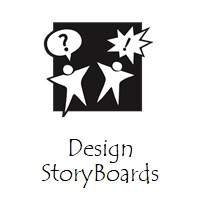
Design Storyboards prevent people from starting and running meetings without an explicit design
The Liberating Structure “Design Storyboards” seems an odd one when you read it for the first time. Until you realize that it is designed specifically to help groups make better use of their time together.
Design Storyboards exists to purposefully think about how a group wants to spend time together to most effectively achieve their purpose.
The most common causes of dysfunctional meetings can be eliminated: unclear purpose or lack of a common one, time wasters, restrictive participation, absent voices, groupthink, and frustrated participants. The process of designing a storyboard draws out a purpose that becomes clearer as it is matched with congruent microstructures.
Storyboards invite design participants to carefully define all the micro-organizing elements needed to achieve their purpose: a structuring invitation, space, materials, participation, group configurations, and facilitation and time allocations. Storyboards prevent people from starting and running meetings without an explicit design.
Design Storyboards makes the design and the structuring of gatherings a shared responsibility — and not something that is delegated to an external facilitator, a chairperson, or a manager. While it may be a bit too meta, it effectively gives groups a structure for how to structure their interactions.
Good designs yield better-than-expected results by uncovering tacit and latent sources of innovation.
Four Structural Elements
1. Structuring Invitation
- Invite a design team (a representative subset of the group) to create a detailed plan, including visual cues, for how participants will interact to achieve their purpose
2. How Space Is Arranged and Materials Needed
- An open wall with tapestry paper or flip-chart pages
2-by-4-inch Post-its and/or Liberating Structures Playing Cards - A blank storyboard (create a spreadsheet)
3. How Participation Is Distributed
- Everyone involved in the design and planning of the meeting has an equal opportunity to contribute
- 1-2-All or 1-All in rapid cycles for each step below
4. Sequence of Steps and Time Allocation
- Clarify the purpose of your work together (use Nine Whys if needed). 2 to 5 min.
- Describe the standard approach or microstructure you would normally use for this session (including who is normally present) and assess how it succeeds and fails in achieving the stated purpose. 5 to 10 min.
- Reexamine and strengthen the purpose statement if needed. 2 to 5 min.
- Reexamine and decide who needs to participate or be involved. 2 to 5 min.
- Brainstorm alternative microstructures (both conventional and Liberating Structures) that could achieve the purpose. Determine whether the purpose can be achieved in one step. If not, what must be the purpose of the first step? Continue with first step only. 5 to 10 min.
- Determine which microstructures are best suited to achieving the purpose; choose one plus a backup. 2 to 10 min.
- Decide who will be invited and who will facilitate the meeting. Enter all your decisions in the blank storyboard. 2 to 10 min.
- Determine the questions and process you will use to evaluate your design (e.g., Did the design achieve desired outcomes? Did the group work together in a productive way? Does something new seem possible now? Use What, So What, Now What?) 2 to 5 min.
- If multiple steps are needed, confer with the design team and arrange a meeting to work on an Advanced Design StoryBoard. 5 to 10 min.
Spreadsheet Example

Purposes and Objectives
- Evoke a purpose that is clear for all
- Make the work in meetings productive and enjoyable for all
- Give everyone a chance to make contributions
- Foster synergy among participants
- Help everyone find his or her role by making the design process visible
- Reveal the weaknesses of the current practice and step up from it
- Tap all the sources of knowledge for innovation (explicit, tacit, latent/emergent)
Tips
- Encourage and seriously play with fast iterations; repeat and deepen your design
- At a minimum, work in pairs (a second set of eyes and ears really helps) or small groups
- Use icons and sketches to quickly develop shared understanding and actionable ideas
- Always include a design debrief (What, So What, Now What?)
- Don’t skimp on the time necessary to generate a good design. A good design will reduce wasted meeting time by much more than it took to create it. A bad design will generate frustration.


